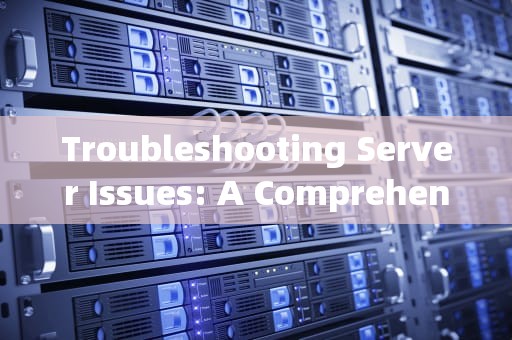In the realm of digital infrastructure, servers serve as the backbone of modern businesses, facilitating data storage, processing, and distribution. However, like any sophisticated machinery, servers are prone to encountering issues that can disrupt operations and impact productivity. This guide aims to provide a comprehensive overview of common server problems, their potential causes, and effective troubleshooting strategies to mitigate these challenges.

Common Server Problems and Their Causes
1、Hardware Failures: Over time, components such as hard drives, RAM modules, or power supplies may fail due to wear and tear, overheating, or manufacturing defects. Regular maintenance and monitoring can help identify and replace faulty hardware before it leads to server downtime.
2、Software Bugs and Corruption: Software glitches, whether in the operating system, applications, or firmware, can cause instability or crashes. Additionally, file system corruption can result from improper shutdowns, software conflicts, or malware infections.
3、Network Connectivity Issues: Servers rely on stable network connections for communication. Problems such as IP conflicts, misconfigured network settings, or physical layer issues (like damaged cables) can impede access and communication between the server and clients.
4、Performance Bottlenecks: Insufficient resources (CPU, memory, disk space) can slow down server performance. High traffic volumes, resource-intensive applications, or inefficient code can also contribute to sluggishness.
5、Security Breaches: Cyberattacks, including malware, ransomware, and DDoS attacks, pose significant threats to server security. Vulnerabilities in software, weak passwords, or outdated systems can be exploited by malicious actors.
6、Configuration Errors: Misconfigurations in server settings, firewall rules, or application setups can lead to service unavailability or erratic behavior. It's crucial to document changes and have a rollback plan in place.
7、Power Outages and Surges: Unexpected power disruptions or surges can cause immediate server shutdowns or permanent damage if adequate protection measures (like Uninterruptible Power Supplies - UPS) aren't in place.
Troubleshooting Steps
1、Initial Assessment: Start by confirming the symptoms and identifying the scope of the issue. Is it affecting a single user, a group, or the entire organization? Note any error messages or unusual behavior.
2、Check Physical Connections: Ensure all cables, including power and network cords, are securely connected. Inspect for signs of damage or wear.
3、Reboot the Server: While seemingly simple, rebooting can resolve many temporary issues and clear out memory leaks or software conflicts.
4、Monitor System Logs: Review logs for error messages or warnings that could indicate the root cause of the problem. Most operating systems maintain detailed logs accessible through command line interfaces or logging software.
5、Run Diagnostic Tools: Utilize built-in diagnostic utilities or third-party tools to check hardware health (e.g., SMART status for hard drives), network connectivity, and system performance metrics.
6、Update and Patch: Ensure the server's OS, applications, and firmware are up-to-date with the latest security patches and updates to address known vulnerabilities.
7、Check Resource Utilization: Use monitoring tools to assess CPU, memory, disk, and network usage. Identify any processes consuming excessive resources and consider optimizing or limiting their impact.
8、Review Security Settings: Verify firewall rules, antivirus definitions, and access controls to ensure they're not inadvertently blocking legitimate traffic or allowing unauthorized access.
9、Consult Documentation and Support: If troubleshooting steps fail, refer to the server's documentation or reach out to the software/hardwarevendor’s support team for assistance. Having detailed records of incidents can expedite resolution.
10、Implement Redundancy and Backup Plans: To minimize future disruptions, implement redundant systems, regular backup schedules, and disaster recovery plans. Regularly test backups to ensure data integrity and quick restore capabilities.
Preventive Measures
Regular Maintenance: Schedule routine checks and maintenance tasks to keep hardware and software in optimal condition.
Monitoring: Employ proactive monitoring solutions to detect issues early and take corrective actions before they escalate.
User Training: Educate users on best practices for security, such as strong password policies and recognizing phishing attempts.
Environment Control: Maintain a controlled environment with appropriate temperature, humidity, and power conditioning to protect against environmental hazards.
In conclusion, while server issues are inevitable, being prepared with a systematic approach to troubleshooting and preventive measures can significantly reduce downtime and ensure business continuity. By understanding the common causes of implementing robust monitoring, and fostering a culture of proactive maintenance, organizations can enhance their server infrastructure's resilience and reliability.
随着互联网的普及和信息技术的飞速发展台湾vps云服务器邮件,电子邮件已经成为企业和个人日常沟通的重要工具。然而,传统的邮件服务在安全性、稳定性和可扩展性方面存在一定的局限性。为台湾vps云服务器邮件了满足用户对高效、安全、稳定的邮件服务的需求,台湾VPS云服务器邮件服务应运而生。本文将对台湾VPS云服务器邮件服务进行详细介绍,分析其优势和应用案例,并为用户提供如何选择合适的台湾VPS云服务器邮件服务的参考建议。

工作时间:8:00-18:00
电子邮件
1968656499@qq.com
扫码二维码
获取最新动态
